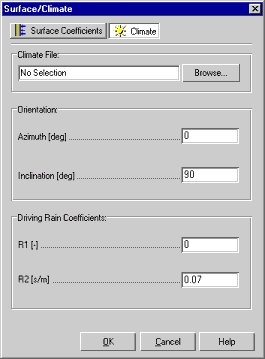2D:Dialog EditClimate
Dialog: Edit Climate
Use this dialog to select the climate to be assigned to the current surface segment of the component and to specify the orientation and exposure of the surface.
"Climate File"
Select the
climate to which the
current surface segment shall be
exposed. The Browse button opens the
"Select Climate" dialog where you
can select from a variety of climate files (provided with WUFI or supplied
by yourself) or different interior climate models.
"Orientation"
The azimuth is the compass direction towards which the building component is facing. It is needed for calculating the rain and radiation loads incident on the surface. Due south is 0°, north is 180°, east is -90° and west is 90°. The inclination is the tilt of the surface. It is needed for calculating the rain and radiation loads incident on the surface.
- 90°:vertical surface
- 0°:horizontal surface
"Driving Rain Coefficients"
The driving rain coefficients are used to estimate the
driving rain load on the building component. The
rain load on a wall is determined by the driving rain rather than the normal rain.
The driving rain coefficients R1 and R2 serve to estimate the driving
rain load on a surface of arbitrary orientation and inclination from data on normal
rain, wind velocity and mean wind direction, using the relation
where 'rain' is the normal rain and 'wind velocity' is that
component of the mean wind velocity (measured at a height of 10 m, in open area),
which is orthogonal to the building surface. This component is determined from
the mean wind velocity and the mean wind direction. The data on normal rain,
wind velocity and wind direction are read from the selected
weather file.
R1 and R2 are strongly dependent on the specific location on the building facade.
For vertical surfaces, R1 is zero. R2 is about 0.2 s/m at free-standing locations
without influence from surrounding buildings etc.; it is markedly less in the
center of a facade (e.g. 0.07 s/m); it may even be greater at exposed locations
of a building (near edges and corners).
Note: Since most component surfaces - with the exception of unrendered
masonry and natural stone facades - only have a moderate water absorption,
they cannot imbibe all the offered water anyway. In these cases, an exact
knowledge of the driving rain quantity is not essential (whereas the duration
of the rain is still important) and fairly plausible estimates for the driving
rain load are usually sufficient (the same is true for the
rain water absorption factor).
